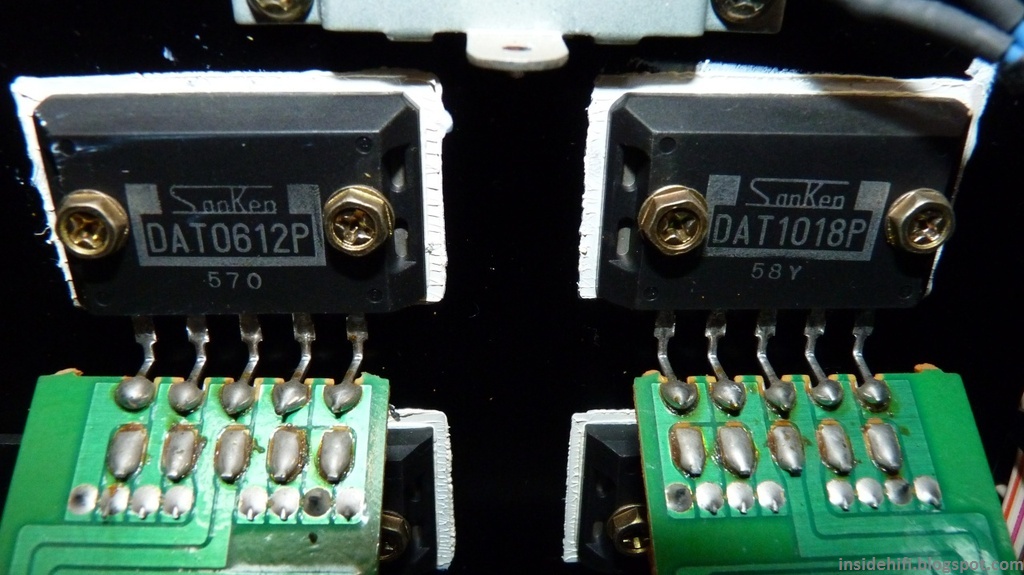Been searching for over 30 years myself... thats how I got to this post. There is no data sheet per se, as these were custom/proprietary devices Sanken made for the Kenwood adaptive class-G VIG-DLD amplifiers.
I think the P/N's on the name denotes a PNP or NPN type.
The 10 is probably 10 Ampere and 18 denotes 180vce part
This theory put up by Dan Mattis (an old friend) bears out of you look at the various models that Kenwood used them in. The 3 types I know of are the
DAT0612
DAT1018
DAT1521
The first 2 were used in the high/low rails of the 120-150watt amps.
The latter 2 in the high/low rails of the Basic M2/M2a 220 watt power amp. Its rails were +/-91.2vdc, needing a minimum vce of 182.4, and the DAT1521's were presumeably 210vce devices... ties out.
I did an hfe reading on one of my DAT1018's and it read 84. Great for 30 years ago, but modern types, average.
The transistor pack has 2 dies or 2 transistors inside sharing the same collector pin/leg, which is the center leg.
The PINout's of the 5 legs are as follows: B-E-C-E-B or B1-E1-C-E2-B2 depending how you want to see it.
I am sure with the 2 heatsink holes drilled, you could easily install 2 regular output devices in that space, perhaps something like the njw0302/njw0281's. They will match the vce/hfe requirements. I have no idea of the cob/power rating/SOA characteristics... but given that the Basic M2A would clip at close to 250 watts into 8 ohms, suggests each DAT1521 part to be between 200-300 watt part.
Hope this helps you or anyone else looking for information on these parts.
I think the P/N's on the name denotes a PNP or NPN type.
The 10 is probably 10 Ampere and 18 denotes 180vce part
This theory put up by Dan Mattis (an old friend) bears out of you look at the various models that Kenwood used them in. The 3 types I know of are the
DAT0612
DAT1018
DAT1521
The first 2 were used in the high/low rails of the 120-150watt amps.
The latter 2 in the high/low rails of the Basic M2/M2a 220 watt power amp. Its rails were +/-91.2vdc, needing a minimum vce of 182.4, and the DAT1521's were presumeably 210vce devices... ties out.
I did an hfe reading on one of my DAT1018's and it read 84. Great for 30 years ago, but modern types, average.
The transistor pack has 2 dies or 2 transistors inside sharing the same collector pin/leg, which is the center leg.
The PINout's of the 5 legs are as follows: B-E-C-E-B or B1-E1-C-E2-B2 depending how you want to see it.
I am sure with the 2 heatsink holes drilled, you could easily install 2 regular output devices in that space, perhaps something like the njw0302/njw0281's. They will match the vce/hfe requirements. I have no idea of the cob/power rating/SOA characteristics... but given that the Basic M2A would clip at close to 250 watts into 8 ohms, suggests each DAT1521 part to be between 200-300 watt part.
Hope this helps you or anyone else looking for information on these parts.
Last edited:
Been searching for over 30 years myself... thats how I got to this post.
What a crazy coincidence, you just replied to a thread from 2006, but a family friend is dropping an amp off for me to try and repair tomorrow that uses these outputs - it's a KA-1100SD.
Inside Hi-Fi: Kenwood KA-1100SD
Thanks very much for sharing what you know, it's already been useful.
Fingers crossed the outputs aren't blown, I feel if the problem is anything else then the amp can live. Both gender devices appear to have the P suffix so I'm not sure which is PNP and NPN, but I'm sure that can be figured out.
Hopefully I can ask you a few more questions in the near future!

- Status
- This old topic is closed. If you want to reopen this topic, contact a moderator using the "Report Post" button.